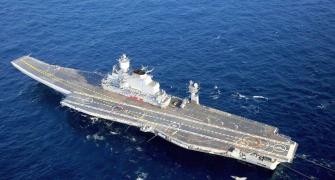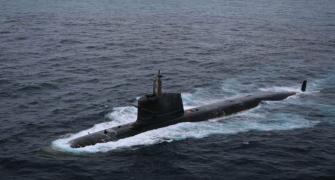Two navy destroyers, the INS Kochi and INS Chennai, fired MR-SAMs simultaneously at two simulated incoming missiles.
Ajai Shukla reports.

The eponymous Medium Range Surface to Air Missile (MR-SAM), jointly developed by India and Israel to defend the navy's warships against incoming anti-ship missiles, achieved a crucial landmark on Friday, May 17.
MR-SAMs fired simultaneously from different vessels were directed to two different targets by a single warship, allowing a naval flotilla to reduce its give-away electromagnetic signature.
Warships typically switch on their multi-function surveillance and target acquisition radar (MF-STAR) while firing an MR-SAM -- usually when an incoming anti-ship missile is still over a hundred kilometres away.
The radar guides the missile towards the target, bringing it close enough to allow the missile's seeker to home onto the anti-ship missile, and strike it precisely while it is still 70 km away.
If a second incoming anti-ship missile is detected, another warship launches a missile to down it. But heavy electronic signatures from multiple radars make the flotilla easily detectable, allowing the enemy to target it with anti-radiation missiles (ARMs).
This vulnerability was reduced through the 'cooperative engagement firing' tested on Friday. Two navy destroyers, the INS Kochi and INS Chennai, fired MR-SAMs simultaneously at two simulated incoming missiles.
But then, INS Chennai kept its radar switched off, while INS Kochi directed both missiles to the target through electronic data links.
'The missiles of both ships were controlled by one ship to intercept different aerial targets at extended ranges... The Indian Navy has become a part of a select group of navies that have this niche capability,' stated the defence ministry.
This allows large naval formations such as an aircraft carrier battle group, which typically includes a carrier, along with several large warships like destroyers or frigates, to operate with a greatly reduced 'electromagnetic signature'.
Meanwhile, the Indian Navy's critical mission to watch over the Indian Ocean is being undermined by a capital budget that has declined on a real basis.
Plans to buy a fleet of Sea Guardian unmanned aerial vehicles (UAVs) -- commonly called drones -- and more than double the P-8I Poseidon multi-mission maritime aircraft (MMAs) fleet have been pared down, say navy planners.
India was planning to buy 22 Sea Guardian drones for the navy, a purchase worth $2 billion. There was another $4 billion plan to expand the P-8I Poseidon fleet up to 28 aircraft, to build an adequate fleet of long-range maritime reconnaissance assets.
But now the navy is buying only 10 Sea Guardians and expanding its P-8I fleet to just 20 to 22 aircraft.
Part of the surveillance task will be taken up by launching a dedicated surveillance satellite that all three services can share.
However, the Sea Guardians now being bought are more capable UAVs than earlier envisioned. Navy sources say the "price and availability" details received recently from Washington are for a Sea Guardian that can carry out long-endurance, high-altitude surveillance, as well as the "hunter-killer" role with its on-board missiles.
Furthermore, the navy's purchase of drones will be done alongside their purchase for the army and air force as well.
US firm, General Atomics, which builds the Sea Guardian for maritime surveillance, will also supply an unspecified number of the MQ-9 Reaper drone, a non-maritime version for the army and air force.
With Washington having green-lighted the purchase of the fully loaded Sea Guardian and MQ-9 Reaper, the military is preparing a 'statement of case'.
Based on this, the Defence Acquisition Council will clear a tri-service procurement, with a single contract for drones for the army, navy and air force.
With India last year joining the Missile Technology Control Regime and signing the Communications Compatibility and Security Agreement (COMCASA) with the US, US export control hurdles to this sale have been significantly lowered.
Currently, all the navy has by way of long range maritime surveillance assets are eight P-8I Poseidons that Boeing delivered between 2013 and 2015.
That $2 billion purchase was supplemented in 2016 with a billion dollar purchase of four more P-8Is, deliveries of which will start in 2020-2021.
Thereafter, the navy will order no more than another 8 to 10, capping the P-8I fleet at 20 to 22 aircraft.
"The P-8I is the world's premier maritime aircraft, but we must scale down, partly to reduce costs. But we will share surveillance responsibilities across platforms," says a senior admiral in New Delhi.
The P-8I and the Sea Guardian complement each other in watching over vast ocean expanses.
The P-8I, which is based upon the Boeing 737 airframe, carries a larger weapons payload, including heavy torpedoes and the Harpoon anti-ship missile that can sink submarines and surface warships. However, being a manned platform, crew fatigue limits the P-8I's endurance to 8 to 10 hours.
In contrast, the Sea Guardian drone can watch for as long as 24 to 36 hours over a patrol area 1,000 km from its base.
Its pilots and weapons operators work in shifts at a ground station ashore, connected with the drone through a two-way data link.
With crewmembers relieving each other every 6 to 8 hours, the Sea Guardian's endurance is limited only by its fuel capacity.
While the Sea Guardian is not as heavily armed as the P-8I, the ones being supplied to India carry two small anti-ship missiles to strike any targets that appear.
Alternatively, the ground station on shore can home in a P-8I to strike the target, or direct fighters like the maritime strike Jaguar.











